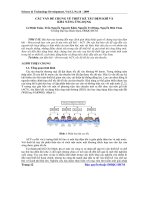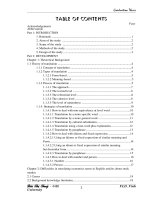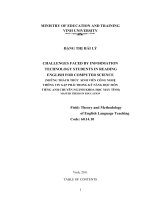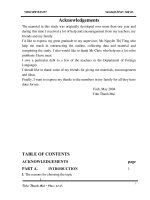Science Articles potx
Bạn đang xem bản rút gọn của tài liệu. Xem và tải ngay bản đầy đủ của tài liệu tại đây (219.37 KB, 8 trang )
Science Articles
How does DNA Fingerprinting Work?
and what can it tell us about wine.
People everywhere expected the new millennium to bring surprises.
But the particular shock and horror that rippled through the
international viticulture community in 2000 was most unexpected. It
had been found that sixteen of the most highly prized varieties of
wine-making grapes were the products of mating between the classic
Pinot and the classically undervalued Gouais grape.
This blew the proverbial cork off the industry's bottle because the Gouais was
considered such an inferior specimen that there were even attempts to ban its
cultivation in France during the Middle Ages. This proves that humble origins can
still produce superior quality. More practically, though, knowledge of their
heritage allows improved breeding of highly desirable subspecies of grape. And
viticulturists everywhere had DNA fingerprinting technology to thank.
DNA fingerprinting is a term that has been bandied about in
the popular media for many years, largely due to its power to
condemn and save, but what does it involve? In short, it is a
technique for determining the likelihood that genetic material
came from a particular individual or group. 99% of human
DNA is identical between individuals, but the 1% that differs
enables scientists to distinguish identity. In the case of the
grapes, scientists compared the similarities between different
species and were able to piece together parent subspecies that
could have contributed to the present prize-winning varieties.
The DNA alphabet is made up of four building blocks – A, C,
T and G, called base pairs, which are linked together in long chains to spell out the
genetic words, or genes, which tell our cells what to do. The order in which these 4
DNA letters are used determines the meaning (function) of the words, or genes,
that they spell.
But not all of our DNA contains useful information; in fact a large amount is said
to be “non-coding” or “junk” DNA which is not translated into useful proteins.
Changes often crop up within these regions of junk DNA because they make no
contribution to the health or survival of the organism. But compare the situation if
a change occurs within an essential gene, preventing it from working properly; the
organism will be strongly disadvantaged and probably not survive, effectively
removing
that altered
gene from the
population.
For this
reason,
random
variations
crop up in the
non-coding
(junk) DNA
sequences as
often as once
in every 200
DNA letters. DNA fingerprinting takes advantage of these changes and creates a
visible pattern of the differences to assess similarity.
Stretches of DNA can be separated from each other by cutting them up at these
points of differences or by amplifying the highly variable pieces. „Bands‟ of DNA
are generated; the number of bands and their sizes give a unique profile of the
DNA from whence it derived. The more genetic similarity between a person – or
grape – the more similar the banding patterns will be, and the higher the
probability that they are identical.
In the non-coding regions of the genome, sequences of DNA are
frequently repeated giving rise to so-called VNTRs - variable
Left - DNA fingerprints from 6 different people, 1 in
each lane (column).
DNA can be cut into shorter pieces by enzymes called
"restriction endonucleases". The pieces of DNA can
then be separated according to their size on a gel.
Each piece of DNA forms a band (the white lines on
the gel). The smallest pieces travel the furthest and
are therefore closest to the bottom of the gel. The
larger pieces travel shorter distances and are closer
to the top.
number tandem repeats. The number of repeats varies between
different people and can be used to produce their genetic
fingerprint. In the simple example shown above, person A has
only 4 repeats whilst person B has 7. When their DNA is cut
with the restriction enzyme Eco RI, which cuts the DNA at
either end of the repeated sequence (in this example), the DNA
fragment produced by B is nearly twice as big as the piece from
A, as shown when the DNA is run on a gel (right). The lane
marked M contains marker pieces of DNA that help us to
determine the sizes. If lots of pieces of DNA are analysed in this
way, a 'fingerprint' comprising DNA fragments of different
sizes, unique to every individual, emerges.
But why bother? After all, I know where my wine comes from – Tesco's, right?
Well, there are many relevant applications of DNA fingerprinting technology in
the modern world, and these fall into three main categories: To find out where we
came from, discover what we are doing at the present, and to predict where we are
going.
In terms of where we came from, DNA fingerprinting is commonly used to probe
our heredity. Since people inherit the arrangement of their base pairs from their
parents, comparing the banding patterns of a child and the alleged parent generates
a probability of relatedness; if the two patterns are similar enough (taking into
account that only half the DNA is inherited from each parent), then they are
probably family. However, DNA fingerprinting cannot discriminate between
identical twins since their banding patterns are the same. In paternity suits
involving identical twins - and yes, there have been such cases - if neither brother
has an alibi to prove that he could not have impregnated the mother, the courts
have been known to force them to split child care costs. Thankfully there are other,
less “Jerry Springer-esque”, applications that teach us about our origins. When
used alongside more traditional sociological methodologies, DNA fingerprinting
can be used to analyse patterns of migration and claims of ethnicity.
DNA Fingerprinting can also tell us about present-day situations. Perhaps best
known is the use of DNA fingerprinting in forensic medicine. DNA samples
gathered at a crime scene can be compared with the DNA of a suspect to show
whether or not he or she was present. Databases of DNA fingerprints are only
available from known offenders, so it isn't yet possible to fingerprint the DNA
from a crime scene and then pull out names of probable matches from the general
public. But, in the future, this may happen if DNA fingerprints replace more
traditional and forgeable forms of identification. In a real case, trading standards
agents found that 25% of caviar is bulked up with roe from different categories, the
high class equivalent of cheating the consumer by not filling the metaphorical pint
glass all the way up to the top. DNA fingerprinting confirmed that the „suspect‟
(inferior) caviar was present at the crime scene.
In the example shown
on the left, DNA
collected at the scene of
a crime is compared
with DNA samples
collected from 4
possible suspects. The
DNA has been cut up
into smaller pieces
which are separated on
a gel. The fragments
from suspect 3 match
those left at the scene of
the crime, betraying the
guilty party.
Finally, genetic fingerprinting can help us to predict our future health. DNA
fingerprinting is often used to track down the genetic basis of inherited diseases. If
a particular pattern turns up time and time again in different patients, scientists can
narrow down which gene(s), or at least which stretch(es) of DNA, might be
involved. Since knowing the genes involved in disease susceptibility gives clues
about the underlying physiology of the disorder, genetic fingerprinting aids in
developing therapies. Pre-natally, it can also be used to screen parents and foetuses
for the presence of inherited abnormalities, such as Huntington‟s disease or
muscular dystrophy, so appropriate advice can be given and precautions taken as
needed.
Acknowledgement: This article was co-authored with Dr Chris Smith, who also
compiled the images.
- May 2004
References
Make your own DNA fingerprint
DNA From The Beginning
Q's and A's about DNA Fingerprinting
Link:
DNA Fingerprinting in Human Health and
Society
Written by David F. Betsch, Ph.D., Biotechnology Training Programs, Inc. Edited
by Glenda D. Webber, Iowa State University Office of Biotechnology.
Issued in furtherance of Cooperative Extension work, Acts of Congress of May 8
and June 30, 1914, in cooperation with the U.S. Department of Agriculture and
Cooperative Extension Services of Illinois, Indiana, Iowa, Kansas, Michigan,
Minnesota, Missouri, Nebraska, North Dakota, Ohio, South Dakota, and
Wisconsin. June, 1994
Like the fingerprints that came into use by detectives and police labs during the
1930s, each person has a unique DNA fingerprint. Unlike a conventional
fingerprint that occurs only on the fingertips and can be altered by surgery, a DNA
fingerprint is the same for every cell, tissue, and organ of a person. It cannot be
altered by any known treatment. Consequently, DNA fingerprinting is rapidly
becoming the primary method for identifying and distinguishing among individual
human beings.
An additional application of DNA fingerprint technology is the diagnosis of
inherited disorders in adults, children, and unborn babies. The technology is so
powerful that, for example, even the blood-stained clothing of Abraham Lincoln
could be analyzed for evidence of a genetic disorder called Marfan's Syndrome.
The Structure of DNA
The characteristics of all living organisms, including humans, are essentially
determined by information contained within DNA that they inherit from their
parents. The molecular structure of DNA can be imagined as a zipper with each
tooth represented by one of four letters (A, C, G, or T), and with opposite teeth
forming one of two pairs, either A-T or G-C. The letters A, C, G, and T stand for
adenine, cytosine, guanine, and thymine, the basic building blocks of DNA.
The information contained in DNA is determined primarily by the sequence of
letters along the zipper. For example, the sequence ACGCT represents different
information than the sequence AGTCC in the same way that the word "POST" has
a different meaning from "STOP" or "POTS," even though they use the same
letters. The traits of a human being are the result of information contained in the
DNA code.
Living organisms that look different or have different characteristics also have
different DNA sequences. The more varied the organisms, the more varied the
DNA sequences. DNA fingerprinting is a very quick way to compare the DNA
sequences of any two living organisms.
Making DNA Fingerprints
DNA fingerprinting is a laboratory procedure that requires six steps:
1: Isolation of DNA.
DNA must be recovered from the cells or tissues of the body. Only a small
amount of tissue - like blood, hair, or skin - is needed. For example, the
amount of DNA found at the root of one hair is usually sufficient.
2: Cutting, sizing, and sorting.
Special enzymes called restriction enzymes are used to cut the DNA at
specific places. For example, an enzyme called EcoR1, found in bacteria,
will cut DNA only when the sequence GAATTC occurs. The DNA pieces are
sorted according to size by a sieving technique called electrophoresis. The
DNA pieces are passed through a gel made from seaweed agarose (a jelly-
like product made from seaweed). This technique is the biotechnology
equivalent of screening sand through progressively finer mesh screens to
determine particle sizes.
3: Transfer of DNA to nylon.
The distribution of DNA pieces is transferred to a nylon sheet by placing the
sheet on the gel and soaking them overnight.
4-5: Probing.
Adding radioactive or colored probes to the nylon sheet produces a pattern
called the DNA fingerprint. Each probe typically sticks in only one or two
specific places on the nylon sheet.
6: DNA fingerprint.
The final DNA fingerprint is built by using several probes (5-10 or more)
simultaneously. It resembles the bar codes used by grocery store scanners.
Uses of DNA Fingerprints
DNA fingerprints are useful in several applications of human health care research,
as well as in the justice system.
Diagnosis of Inherited Disorders
DNA fingerprinting is used to diagnose inherited disorders in both prenatal and
newborn babies in hospitals around the world. These disorders may include cystic
fibrosis, hemophilia, Huntington's disease, familial Alzheimer's, sickle cell anemia,
thalassemia, and many others.
Early detection of such disorders enables the medical staff to prepare themselves
and the parents for proper treatment of the child. In some programs, genetic
counselors use DNA fingerprint information to help prospective parents
understand the risk of having an affected child. In other programs, prospective
parents use DNA fingerprint information in their decisions concerning affected
pregnancies.
Developing Cures for Inherited Disorders
Research programs to locate inherited disorders on the chromosomes depend on
the information contained in DNA fingerprints. By studying the DNA fingerprints
of relatives who have a history of some particular disorder, or by comparing large
groups of people with and without the disorder, it is possible to identify DNA
patterns associated with the disease in question. This work is a necessary first step
in designing an eventual genetic cure for these disorders.
Biological Evidence
FBI and police labs around the U.S. have begun to use DNA fingerprints to link
suspects to biological evidence - blood or semen stains, hair, or items of clothing -
found at the scene of a crime. Since 1987, hundreds of cases have been decided
with the assistance of DNA fingerprint evidence.
Another important use of DNA fingerprints in the court system is to establish
paternity in custody and child support litigation. In these applications, DNA
fingerprints bring an unprecedented, nearly perfect accuracy to the determination.
Personal Identification
Because every organ or tissue of an individual contains the same DNA fingerprint,
the U.S. armed services have just begun a program to collect DNA fingerprints
from all personnel for use later, in case they are needed to identify casualties or
persons missing in action. The DNA method will be far superior to the dogtags,
dental records, and blood typing strategies currently in use.
For Further Reading
"DNA fingerprints witness for the prosecution." Discover. June 1988, p. 44.
DNA Identity Testing Information Package. Available from LifeCodes, Inc.,
Stamford, Connecticut. Phone toll-free: 1 (800) 543-3263.
Genetic Witness Forensic Uses of DNA Tests. U.S. Office of Technology
Assessment. July 1990. Phone: (202) 224-8996.
"Molecular advances in genetic disease." Science. May 8, 1992.
"The promise and pitfalls of molecular genetics." Science. July 10, 1992.
Link:









